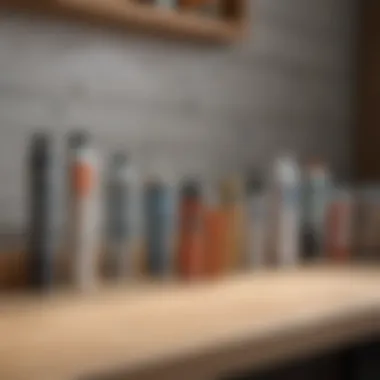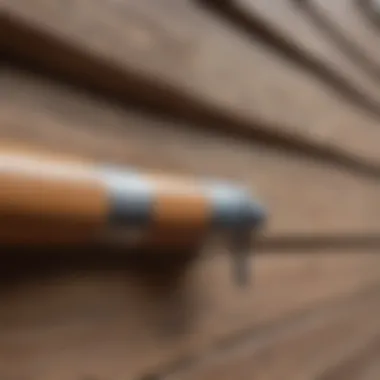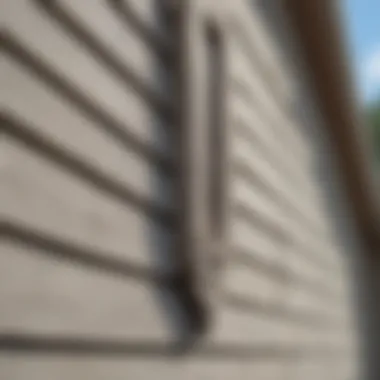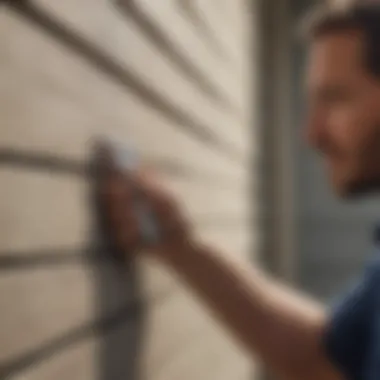Choosing the Right Siding Caulk: A Detailed Guide


Intro
When it comes to home improvement, particularly for exterior surfaces, choosing the right siding caulk is crucial. Siding not only gives your home its character but also protects it from the elements. Without proper sealing, gaps can lead to moisture intrusion, energy loss, and significant damage over time. Understanding the nuances of siding caulk – from its types to its applications – can be a game changer for any homeowner.
Importance of Siding Caulk
Selecting the ideal caulk can often feel like finding a needle in a haystack. There’s a world of options available, each designed for different materials and climates. This choice greatly influences the integrity of your siding, impacting longevity and aesthetic appeal. By investing time in selecting a suitable caulk, homeowners not only enhance the beauty of their homes but also conserve energy and avoid costly repairs down the line.
"A stitch in time saves nine." The preventive nature of caulking cannot be understated in the realm of home maintenance.
In understanding siding caulk, you empower yourself to make informed decisions that will greatly benefit your living space.
Intro to Siding Caulk
When it comes to maintaining the integrity and aesthetics of your home, caulk may not be the first thing that springs to mind. However, it plays a crucial role in siding installations and repairs. This section will equip you with the necessary insights about siding caulk, its application, and why it matters to your household.
Caulk, in essence, is a sealant used to fill gaps and cracks in various surfaces, ensuring that water doesn’t seep in and air doesn’t leak out. Whether you’re a seasoned DIYer or a homeowner seeking some quick fixes, understanding siding caulk can save you both time and money in the long run.
Choosing the right caulk is akin to using the right tool for a job; it can't be overlooked. Problems such as mold, rot, or energy loss can arise if you overlook sealing your siding properly. This guide provides you with various considerations to keep in mind, enhancing your awareness about what type of caulk works best for your project.
Understanding the Role of Caulk
To appreciate why siding caulk is indispensable, consider this: your home's exterior is constantly exposed to the elements. Rain, snow, heat, and cold all take a toll, trying to infiltrate through imperfections and seams. Caulk forms a protective barrier against these forces. It prevents water intrusion, which is a primary cause of wood rot and structural damage over time.
Moreover, a well-sealed home reduces energy costs. Gaps in siding can lead to heat loss in winter and cool air leakage in summer, pushing your HVAC systems to work harder than necessary. This inefficiency translates to unwanted expenses. Proper caulking brings financial benefits alongside enhanced comfort.
On a practical level, caulk also helps to maintain the visual appeal of your home. By filling in cracks and gaps, it contributes to a more polished and finished look, thus adding value and curb appeal.
Importance of Proper Sealing
When it comes to sealing, precision is key. A poor caulking job can create more problems than it solves. It's essential to use the right type of caulk and apply it correctly for optimal results. For instance, using caulk meant for bathrooms on exterior siding may not hold up well against the weather.
Additionally, improper sealing may lead to pests making a home in your walls or contributing extensive water damage that could tear apart insulation and framing. Here are a few points to consider about proper sealing:
- Specific Applications Matter: Ensure that the chosen caulk suits the material of your siding and the environment it's exposed to.
- Look Out For Gaps: Regularly inspect your home for any gaps or signs of deterioration in the caulk, and reapply as necessary.
- Follow Best Practices: Take time to prepare the surface by cleaning it and ensuring it's dry. This helps the caulk adhere better and extend its life.
"Proper caulking preserves not just the look of your house, but its structural integrity!"
Overall, understanding siding caulk not only informs your decisions on home maintenance but also empowers you to take action in preserving the beauty and durability of your home for years to come. Picking the right caulk leads to effective sealing, energy efficiency, and a tidy appearance.
Key Properties of Quality Siding Caulk
When it comes to siding caulk, recognizing its key properties is akin to understanding the backbone of any successful home improvement project. The right caulk not only ensures the aesthetic appeal of your home but also plays a crucial role in safeguarding it from the elements. The factors we will delve into here—elasticity and flexibility, durability and weather resistance, adhesion strength, and ease of application—are essential in determining whether a specific siding caulk will meet your needs. This selection process contributes immensely to the longevity and efficiency of your home’s outer protection.
Elasticity and Flexibility
The first critical property to assess is elasticity and flexibility. Caulk that remains flexible allows it to adapt to the natural movements of a structure, particularly as temperatures fluctuate. For instance, during hot summers and cold winters, materials like wood and metal can expand and contract. If the caulk is too rigid, it risks cracking, which can lead to unsightly gaps and compromised sealing. Choosing a caulk that maintains its elasticity over time will effectively reduce the need for frequent touch-ups and repairs.
Consider products specifically labeled as elastic caulks, such as silicone or polyurethane variants. These types are designed to stretch and compress without losing their sealing ability, providing long-term protection for your home.
Durability and Weather Resistance
Next up is durability and weather resistance. When you invest your time and resources into caulking, you want to ensure that it can withstand the test of time, including the relentless forces of nature. A quality siding caulk should resist UV rays, moisture intrusion, and extreme temperature variations. Using a caulk that begins to break down because of exposure can lead to rot, mold, and other unfortunate results.
For example, a top-notch silicone caulk might offer a higher degree of versatility in terms of weathering conditions. It can handle humid environments, and when applied correctly, it can last many years without needing replacement.
Additionally, always check for manufacturer specifications that indicate the caulk's performance range, as this can serve as a handy guide when matching products with your specific climate.
Adhesion Strength
Another vital aspect is adhesion strength. This property determines how well the caulk can stick to the surfaces you are working with. Poor adhesion can lead to peeling and flaking, compromising the entire purpose of applying caulk in the first place. It’s essential that the selected caulk bonds effectively not only to the siding materials but also to adjacent surfaces.


For instance, when caulking wood siding, look for products that specifically mention compatibility with wood. A strong adhesive quality often keeps water at bay and reduces the potential for rot. Checking reviews or detailed product specifications might provide insights into users’ experiences regarding adhesion over time.
Ease of Application
Lastly, contemplate the ease of application. Even the best caulk can become a headache if it’s challenging to work with. For housewives and homeowners taking on DIY projects, ease of use can be a major selling point. Look for caulks that come in a squeeze tube or cartridges designed for caulking guns, as these can speed up the process and create smoother applications.
Also, consider the drying time and cleanup process. Certain caulks allow for paint to be applied over them shortly after application, which can be a boon for a quicker finish.
Ultimately, a caulk that is simple to apply ensures the project remains manageable and enjoyable, rather than turning into a frustrating endeavor.
In summary, understanding these key properties of siding caulk can save both time and effort in the long run while effectively protecting and beautifying your home.
Types of Siding Caulk
Understanding the various types of siding caulk is crucial for any homeowner looking to seal and protect their exterior. Each type of caulk has unique properties, making them suitable for different applications and siding materials. By knowing what each type offers, you can select the right option that aligns with your specific needs. This knowledge not only enhances the longevity of your siding but also optimizes your investment in home maintenance. Here, we'll delve into four common types of caulk: acrylic, silicone, polyurethane, and latex.
Acrylic Caulk
Advantages and Disadvantages
Acrylic caulk is often favored for its ease of application and paintability. One of its standout features is water clean-up, which makes it accessible even for DIY enthusiasts. However, it tends to be less durable when exposed to the elements compared to other types, making it more suitable for interior applications or places protected from harsh weather. While it might be a go-to choice for many smaller projects around the house, its lesser elasticity and water resistance can present challenges in outdoor uses. With its pros, the question arises: can its cons be overlooked for specific minor projects?
Best Uses
Acrylic caulk works well for sealing gaps and joints between siding and trim. It’s particularly effective in environments where the movement of building components is minimal. Ideal for indoor applications, it’s perfect for indoor molding, windows, and filling cracks in drywall. Its paintable nature allows homeowners to blend it seamlessly with their interior design. Homeowners favor this caulk type for jobs where aesthetics matter as much as functionality but need to remember to re-evaluate its placement for lasting impact.
Silicone Caulk
Advantages and Disadvantages
Silicone caulk shines with its exceptional waterproof properties and flexibility. It’s highly resistant to mildew, making it a favorite in bathrooms and kitchens. However, applying silicone caulk can be a little trickier. Once it cures, it can be challenging to paint over it, which may not suit every project. This trade-off often makes homeowners ponder whether the pros outweigh the cons when jobs demand a clean finish.
Best Uses
Silicone caulk is ideal for situations where water exposure is a concern. It’s perfect for bathtubs, sinks, and even lobbies of buildings that experience high moisture levels. Some homeowners lean toward silicone for outdoor siding applications as well. However, it’s important to consider its lack of paintability; thus, it’s essential to identify where its unique properties can truly shine, rather than attempting to camouflage it with a layer of paint.
Polyurethane Caulk
Advantages and Disadvantages
Polyurethane caulk stands tall thanks to its durability and robustness, making it great for heavy-duty jobs. It adheres well to a variety of materials, and its flexibility allows it to handle temperature fluctuations effectively. On the downside, it can be more challenging to apply, and its cleanup process can pose some hurdles, often requiring solvents rather than water. The unique characteristics invite debate among homeowners: does versatility come with too high a price?
Best Uses
Polyurethane caulk is generally the choice for outdoor projects. It’s particularly suited for wood siding and other materials exposed to the elements. It’s also effective for filling gaps in foundations and connecting different building materials. The takeaway here is recognizing that its unique strengths make it indispensable for specific applications, helping homeowners confidently tackle significant projects that cannot afford to fizzle out prematurely.
Latex Caulk
Advantages and Disadvantages
Latex caulk is often valued for its wide range of applications and ease of use. It’s easy to apply, cleans up with water, and typically doesn’t emit strong odors during installation. However, it doesn’t offer the same level of durability as silicone or polyurethane, particularly in extreme weather conditions. This raises questions about where this caulk really fits in a homeowner's toolkit.
Best Uses
Latex caulk is best for interior applications, such as sealing gaps in trim and around windows. It’s also good for quick touch-ups and being paintable, making it a practical option for small repairs within the home. Its advantages provide a good solution for less demanding tasks, but it's wise to avoid relying on it for exterior projects that may face inclement weather over time.
Conclusion: Knowing the types of siding caulk available can save time, effort, and money. Each type presents its own strengths and weaknesses that can play a critical role in deciding which to use in your projects.
Choosing the Right Caulk for Different Siding Materials
Selecting the proper caulk tailored to specific siding materials isn't just a matter of preference; it's a pivotal decision that directly affects both the aesthetic and functional longevity of your home. Different siding materials have unique characteristics, and understanding them can help homeowners achieve optimal moisture protection, prevent air leaks, and improve the overall look of their exterior. So, when the time comes to choose, the right caulk can keep your house standing tall against the elements while enhancing its appeal.
Vinyl Siding


Vinyl siding enjoys popularity due to its durability and low maintenance. However, using the correct caulk is essential for several reasons. Vinyl expands and contracts with temperature changes, and if the caulk used isn't flexible enough, it may crack over time.
Best Options: For vinyl siding, silicone and acrylic latex caulks are typically preferred. Silicone offers excellent flexibility and durability, crucial for withstanding temperature variations. Moreover, acrylic latex caulk, while easy to apply and paint, might not hold up as well in extreme conditions, so choose one branded specifically for vinyl siding.
Wood Siding
Wood is a classic choice, but it comes with its own set of issues. Moisture infiltration can lead to rot and decay, making the sealing process paramount. A caulk that not only adheres well to wood but also allows for natural movement is vital here.
Best Options: Polyurethane caulk is often regarded as ideal for wood, as it offers exceptional adhesion and durability. Another good choice is acrylic latex caulk, particularly if you're looking for paintability. Both caulks work well, provided they are used correctly and reapplied as necessary to combat wear.
Fiber Cement Siding
Fiber cement siding is often touted for its resilience and longevity, yet it too requires the right caulk to defend against water intrusion. When dealing with fiber cement, it’s important to ensure that the caulk chosen can comfortably handle the material’s characteristics without becoming brittle.
Best Options: Silicone or polyurethane caulks are excellent candidates here. They offer superior moisture resistance and flexibility, which are essential given the nature of fiber cement. When applying, it's important to follow the manufacturer's guidelines to ensure a proper seal is made, keeping elements at bay.
Metal Siding
Metal siding is prized for its modern aesthetic and durability, but it poses distinct challenges. Metal can expand and contract significantly, which requires careful consideration in terms of which caulk to use.
Best Options: For metal siding, neutral-cure silicone caulk is recommended. It adheres well to metal surfaces, remains flexible, and isn't corrosive, which is crucial when protecting your investment long term. Avoid using caulks that might contain solvents that could damage the metal over time.
Choosing the right caulk involves understanding the unique attributes of the siding materials. By selecting caulk that complements these attributes, homeowners can ensure that their siding not only looks great but can withstand the rigors of weather over the years.
Application Techniques for Siding Caulk
Understanding the right application techniques for siding caulk is crucial for achieving the best results in any siding project. Poor application not only diminishes the effectiveness of the caulk but could also lead to costly repairs in the future. This section serves to highlight the importance of utilizing proper tools and techniques to ensure that homes are effectively sealed against moisture, air leaks, and pests. The benefits are clear: longevity of siding materials, reduced energy costs, and peace of mind.
Tools Required
To start off on the right foot, having the correct tools at hand can make a world of difference. Here’s a concise list of essential tools you’ll need:
- Caulking gun: This tool is a must-have for dispensing caulk smoothly and evenly. Look for one that’s easy to squeeze.
- Utility knife: Great for trimming the caulk tube and cleaning up any product that goes awry.
- Putty knife: Useful for applying caulk and smoothing out the seams.
- Tape: Painters tape will help ensure clean edges where caulk meets siding.
- Rags or paper towels: For quick clean-ups.
- Caulk remover tool: If you’re replacing old caulking, this tool can save time.
With these tools ready, one can dive into the task with confidence.
Surface Preparation
Before applying caulk, surface preparation is key. This part of the application process often gets overlooked, but it’s as crucial as the caulk itself. Properly cleaned surfaces ensure that the caulk adheres better and lasts longer.
First, remove any old caulk using a utility knife or caulk remover tool. Dust, dirt, and grease can hinder adhesion, so make sure to clean the area thoroughly. A scrub with soap and water followed by a rinse will suffice in many cases. Let the surface dry completely before proceeding. Some may find it helpful to use a primer in areas where the siding material is porous. It can enhance adhesion, which prevents future peeling or bubbling of the caulk.
Caulking Process
Applying the Caulk
Applying the caulk is where the magic (and the mess) happens. The key characteristic of this step is the application angle and consistency. Hold the caulking gun at a 45-degree angle to the gap you're filling. This approach provides control and an even bead.
A popular choice for many is the squeeze-and-glide technique — squeeze the trigger gently, allowing a consistent ribbon of caulk to fill the joint without any skips or breaks. Why is this method favored? It delivers a smoother finish, reducing the need for excessive smoothing techniques afterward. Just a subtle pull back on the trigger can sometimes avoid overfilling, which can lead to wastage.
However, one needs to be cautious; a gentle approach often means a slower application, which can test one's patience.
Smoothing Techniques
Smoothing techniques can make or break the caulking look. Once the caulk is applied, it’s crucial to smooth it out to ensure a secure seal. A finger dipped in water is a classic method — the moisture helps to glide your finger over the caulk without it sticking and pulls off any excess. The beauty of this technique lies in its simplicity; it gives the caulk a clean, professional finish without needing special tools.
Alternatively, a putty knife can also be used if that suits your style better. The unique aspect of smoothing out caulk effectively is it not only looks better but also reduces the chance of moisture infiltrating gaps. The advantages? A well-smooth caulk bead can provide a sleek appearance that complements and enhances the exterior of the home.
"Smoothing is not just for looks; it’s a defense mechanism against nature. A little extra effort here goes a long way."
In summary, mastering application techniques for siding caulk isn’t just about quick fixes. It’s a multi-step process ensuring long-lasting protection for your siding investment. Attention to detail while applying and smoothing caulk will futher contribute to the overall effectiveness of the sealing operation, fortifying your home against elements and ensuring durability.
Maintenance and Longevity of Caulk


Proper maintenance and longevity of caulk are crucial elements to understand when embarking on any siding project. Without regularly checking and maintaining the integrity of your caulk, you could end up with significant damage later on. Neglecting this aspect can lead to water intrusion, mold growth, and even structural issues that will cost you a pretty penny to rectify.
To ensure that your home stays sound and visually pleasing, it is vital to recognize the signs of wear and to know when to take action.
Signs of Deterioration
- Cracking or Splitting: One of the most common indicators of degradation is visible cracks or splits in the caulk line. If you can see gaps, it's a sure sign that the caulk is losing its ability to seal properly.
- Peeling or Lifting: If you notice the caulk pulling away from the surfaces it’s meant to protect, removal is necessary. This peeling indicates that the adhesion is failing.
- Discoloration: Sometimes, the color can shift, but it also might come with a musty odor. This change could signal mold growth.
- Moisture Presence: Feel for damp spots or see visible water accumulation where caulk is supposed to protect. This hints that the barrier is compromised.
"An ounce of prevention is worth a pound of cure."
When to Reapply
Knowing when to replace caulk is just as crucial as understanding the signs of deterioration. Here are some guidelines to help you decide when it's time to reapply:
- Every Five Years: Generally, it’s wise to check your caulk every five years. While some high-quality caulks can last longer, regular inspections help you stay ahead of the game.
- After Major Weather Events: If you live in an area prone to harsh weather, inspect your caulking after heavy rain, wind, or snow. These events can put your caulk to the test.
- Building Maintenance: Any routine maintenance, such as painting or cleaning, should include an evaluation of your existing caulk. If any signs of wear are present, take action.
- Before Selling Your Home: Consider reapplying caulk before putting your home on the market. A tightly sealed home indicates that proper maintenance has been prioritized, making for a more appealing selling point.
Staying mindful of these aspects not only helps in maintaining the longevity of your caulk but also extends the overall life of your siding, ultimately providing peace of mind and savings on future repairs.
Common Mistakes in Caulking Siding
Caulking is one of those tasks that, if done right, you hardly notice. But when it's done wrong, it can stick out like a sore thumb. Several common blunders can undermine the effectiveness of this crucial sealing process. Recognizing these errors is not just about avoiding an unsightly finish, but also about ensuring the longevity and effectiveness of the caulking itself. Let's unpack a few of these missteps, keeping in mind that even seasoned DIYers can occasionally falter in these areas.
Using Incompatible Caulk
One of the primary mistakes is selecting the wrong type of caulk for your specific siding material. Each type of siding—be it vinyl, wood, or metal—has unique requirements.
- Understanding Compatibility: Not all caulks bond well with certain surfaces. For instance, silicone caulk doesn't properly adhere to painted surfaces, which is often found in wood siding.
- The Consequences: If you use an incompatible caulk, you might end up with leaks or even peeling caulk within a short time. This is not just frustrating but can lead to more significant repairs down the line.
The right product ensures that you maintain a tight seal, preventing moisture intrusion and unwanted air leaks. So, always read the label and do a little homework before buying.
Skipping Surface Preparation
Ah, the classic error of jumping in without preparing the battlefield. In caulking, preparation is everything. A clean, dry surface promotes better adhesion and a longer-lasting seal.
- Cleaning Groundwork: Dust, dirt, and grime can create barriers between your caulk and the siding material. Giving the surface a good scrub means your caulk has a fighting chance to do its job.
- Why It's Important: Without proper preparation, the caulk can fail almost immediately. Imagine spending an afternoon caulking your home, only to find it peeling off after a few months. You wouldn’t be too happy, would you?
It's worth investing the extra time for cleanup; it pays off in the durability and performance of your work.
Poor Application Technique
Even the best caulk can turn into a mess if the application technique is lacking. It's not exactly rocket science, but it does require a bit of finesse.
- The Right Tools: Using a caulking gun seems straightforward, yet many struggle with the pressure control or tip size. Too much pressure and caulk oozes everywhere; too little and you get a feeble line that doesn’t fill gaps properly.
- Smoothing It Out: A common practice, often overlooked, is smoothing the bead of caulk after application. A well-smooth line not only looks professional but also helps the caulk to fill in any small gaps. A wet finger or a smoothing tool can do wonders here.
Smoothing the caulk improves adhesion and gives your project a clean, finished look, indicating that you cared about the details.
These are just snapshots of some common missteps people make when caulking siding. Taking a little time to avoid these pitfalls can lead to significant improvements in your project outcomes.
Finale
In wrapping up our comprehensive guide on siding caulk, it becomes clear that choosing the right type and application methods truly matters. Several aspects contribute to a successful outcome in any siding project. Understanding the properties of caulk, the various types available, and recognizing the specific needs of your siding material forms the very foundation of quality work.
Recap of Key Points
To get a clearer picture, let’s revisit some critical takeaways from the article.
- Understanding Siding Caulk: We examined how caulk acts as a protective barrier, keeping moisture and air from infiltrating your home, which is crucial for long-term durability.
- Properties of Quality Caulk: Remember, properties like elasticity, durability, and adhesion strength shouldn't be overlooked. They help determine which product is suitable for your project.
- Types of Caulk: Different caulks serve different purposes. Whether you opt for acrylic, silicone, or polyurethane, knowing the advantages and best uses can greatly influence your decision.
- Application Techniques: The way you apply caulk matters immensely. Proper surface preparation and technique can be the difference between a job well done and one that leads to future issues.
- Maintenance: Just because you've applied caulk doesn’t mean you’re out of the woods. Recognizing the signs of deterioration and knowing when to reapply can save you a headache later.
This recap serves as a quick checklist to help ensure everything is on point before you dive into your next home improvement project.
The Importance of Choice
The choices you make regarding siding caulk can significantly affect not only the aesthetics of your home but its structural integrity as well. For instance, picking between silicone and acrylic might seem trivial, but it comes down to the long-term performance of the seal. In regions with harsh weather, for example, a flexible caulk can withstand expansion and contraction, preventing gaps from forming.
Furthermore, making an informed choice goes beyond just assessing your current needs; it considers future implications too. Choosing the right color might enhance your home’s aesthetics now, but you ought to think about how it will hold up over time. A poor choice might lead to frequent reapplications or worse, water damage.
Ultimately, the importance of your choice lies not just in what looks good today but in what will work best for years to come. As you embark on your next caulking endeavor, keep this notion close to heart.
"The best time to repair the roof is when the sun is shining."







